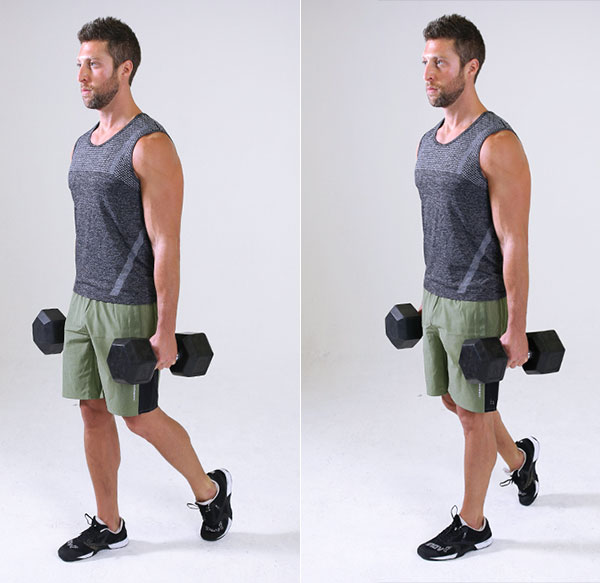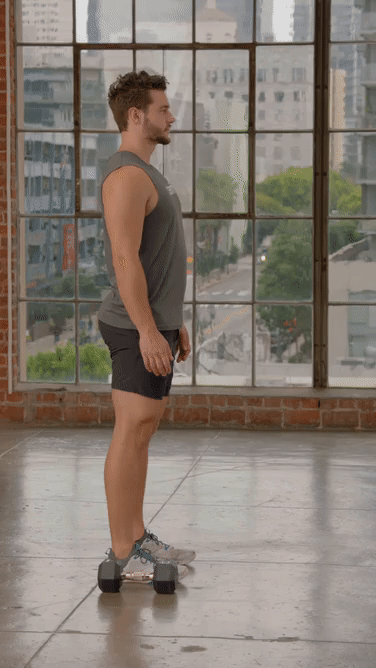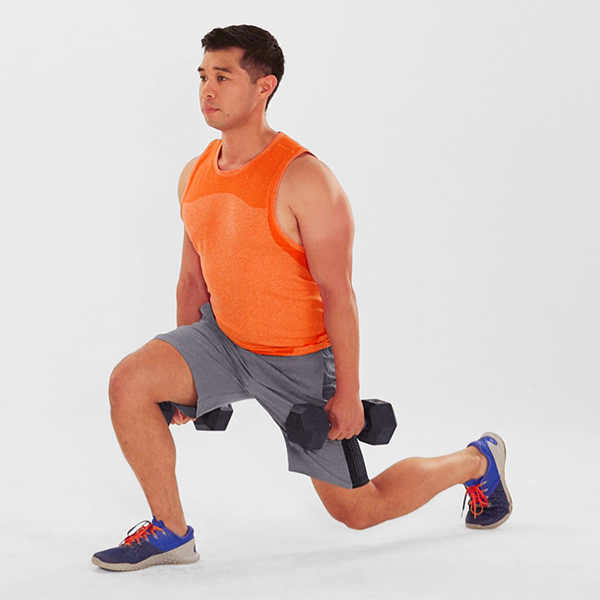Ever seen someone at the gym grab a pair of dumbbells off the rack and just… take them for a walk? They’re doing a move called the farmer’s walk exercise — or, more generically, the loaded carry. And there’s more to the move than meets the eye.
“The farmer’s walk is about as functional as it gets,” says Trevor Thieme, C.S.C.S. “Just try to remember a day when you didn’t pick something up and carry it.”
Here’s how to do it correctly.
Farmer’s Walk: Step-by-Step Instructions

- Stand with your feet hip-width apart holding a pair of heavy dumbbells at your sides, palms facing in.
- Draw your shoulders back, and pull your head back as if making a double chin. Hold this position throughout the movement.
- Keeping your core engaged and your gaze ahead of you, walk for 20-30 seconds to complete a set. Avoid the tendency to sway from side to side.
Farmer’s Walk Benefits
Why might you want to walk your dumbbells like a pair of ultra-lazy chihuahuas? Here are few reasons.
1. It builds grip strength
Since all you’re doing is holding the weights at your sides — no curling, pressing, or extending required — you’ll heft some of the heaviest weights you’ve ever held in your hands. And that’s good: You need grip strength for many different exercises, from deadlifts to chin-ups to rows to lateral raises.
Learn to grip a heavy weight and there’s a good chance your performance on those other moves will improve as well.
2. It helps build your core
The muscles of your abdomen, lower back, and trunk do more than power you through sit-ups and leg lifts: They also protect your spine. The loaded carry forces these core muscles — front, sides, and back — to keep you upright and aligned while you move.
3. It burns tons of calories
The farmer’s walk isn’t just a grip and core move: “It’s truly a total-body exercise, engaging muscles from your deltoids [shoulders] all the way down to your feet,” explains Thieme. The more muscles you activate, the greater the strength and fat-burning benefits.
4. It’s safe
The risk of injury is low on loaded carries, and no spotter is required. If you can’t complete a set, all you have to do is set the dumbbells on the floor. Excluding back pain sufferers, says Thieme, “Everyone who’s fit enough to walk and lift weights should do farmer’s walks.”
Back giving you problems? Get clearance from your doctor.
5. It gets you accustomed to big weights
One key to progress in the gym is lifting progressively heavier weights over time. Get used to heavy weights on the loaded carry, and you’re that much more likely to grab them when you’re pressing, rowing, lunging, or curling. It’s a gateway move, setting the stage for using heavier loads on other moves.
Farmer’s Walk Variations
Wanna spice up your loaded carries? Try one of these challenging variations.
Offset farmer’s walk

Carry weight in one hand instead of two, switching hands halfway through your walk, and working to stay as upright as possible throughout. The unilateral challenge forces the obliques on your non-weighted side to work harder.
Logger’s walk
Walk holding the weights at shoulder level. The higher center of gravity offers a different core challenge, and harder work for your upper body.
Walking lunges

Holding one or two dumbbells at your sides, at shoulder height, overhead, or any combination, take long strides, dropping your back knee close to the floor on each step.
Waiter’s walk
Walk holding one or both weights overhead — a position that challenges shoulder and core stability in an entirely different way. Make sure you have the requisite shoulder mobility for this variation, and start with a lighter weight.
Combo walk
Walk holding one weight at shoulder height, and one at waist height, or one overhead and the other at shoulder height, or any combination of the three positions you can think of. Be sure to use the appropriate weight for each combination, and make sure to perform equal reps on both sides.